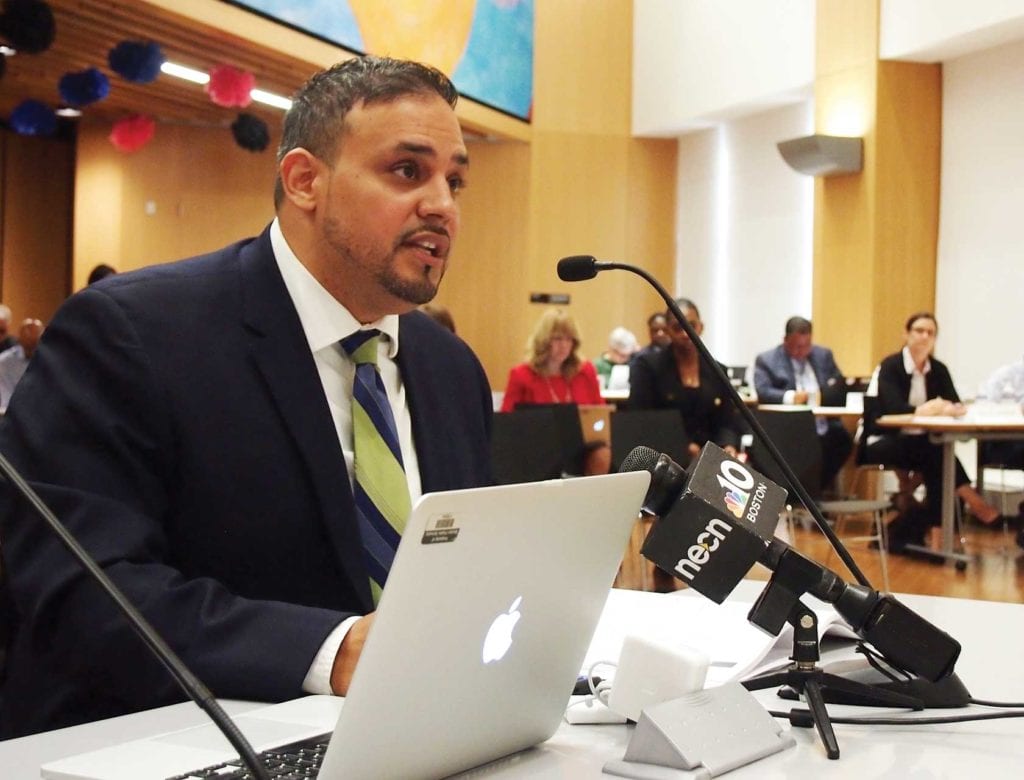
Five years after Boston’s schools switched to a neighborhood-based assignment system and four years after the report was due, Boston Public Schools officials have released an equity analysis report showing a small reduction in the distances students travel to school, less access to top-tier schools for students in black and Latino neighborhoods and a small but statistically significant increase in segregation.
The new report, compiled by a collection of local academics called the Boston Area Research Initiative, found that the BPS Home-Based Assignment Policy “diminished integration across the city without creating neighborhood schools.”
The report also found that only 5 percent of students in the predominantly black and Latino neighborhood of Mattapan had access to top-tier schools, while 80 percent of students in predominantly white Boston neighborhoods had access to top-tier schools.

BPS Interim Superintendent Laura Perille and School Committee Chair Michael Loconto at Monday’s School Committee meeting. Banner Photo
The report’s findings sparked angry reactions from parent groups and civil rights activists, many of whom were opposed to the home-based system in 2013.
“To think that a city as racially segregated as Boston would be positioned to adopt a neighborhood school model, while also cutting access to transportation that would help secure integrated schools, is morally and ethically devoid of racial consciousness,” read a statement issued Monday by a coalition of groups including the NAACP Boston Branch, the Lawyers’ Committee for Civil Rights and Economic Justice and the Boston Education Justice Alliance. “Boston waited far too long to understand the impact of its student assignment system, and students of color disproportionately bear the harm of that mistake.”
Interim BPS Superintendent Laura Perille, who served on a 2012 external advisory committee that helped inform the creation of the home-based system, was more measured in her analysis of the report.
“While the current home-based system might be viewed as a big step forward, the equity analysis shows us is that the implementation is not all the way there,” she said during Monday’s School Committee meeting.
Kevin Murray, a parent with the group Quality Education for Every Student, said the home-based system has exacerbated the inequality and segregation in the schools. He suggested that BPS do more than tweak the implementation of the system.
“When 5 percent of the students in one neighborhood have access and 80 percent of students in another neighborhood do, that’s not an implementation problem; it’s a fundamental, if not fatal, flaw in the system,” he said.
The Home-Based Assignment Policy, launched in 2013, was aimed at returning the city to a neighborhood schools model that would save on transportation costs, create communities around schools and maintain equity of opportunity.
Under the old system, Boston was split into three zones: North, East and West. Students in any one of those zones were eligible to attend any school in the zone in which they resided. Half the seats in any given school were reserved for students living within a one-mile walk of the school.
The new home-based system relies on an algorithm developed by researchers at MIT that selects schools within a one-mile radius of a student’s home address and includes at least two Tier 1 schools, whether or not they’re within the one-mile radius. Yet the report found that there is more competition for fewer seats in Tier 1 schools in predominantly black and Latino neighborhoods.
Report co-author and Northeastern University professor Daniel O’Brien said the greatest challenge for residents in the predominantly black and Latino neighborhoods in Roxbury, Dorchester, Mattapan and Hyde Park is the relative lack of Tier 1 schools in those neighborhoods.
“It’s hard to provide students with high quality schools close to home if there are no high quality schools close to home,” he said.
O’Brien said the increase in segregation was small, but statistically significant.
“These results were not alarming in their magnitude, but they do reflect a potentially troubling trend,” the report reads.
The report also found that among students who use buses to get to school, the average trip was reduced by a half-mile, saving students an average of three minutes each way.
Parents and activists who testified at the School Committee meeting Monday expressed disappointment with the home-based assignment system and with BPS for delaying the release of its equity analysis, which officials had promised would come out yearly.
“The report released today by the BARI ratifies findings about public education that we have known to be true for decades: that separate will never be equal,” said Jose Lopez, head of the NAACP Boston Branch Education Committee. “And in a school district where address equals access, a segregated city cannot provide an equal education to all its children.”






